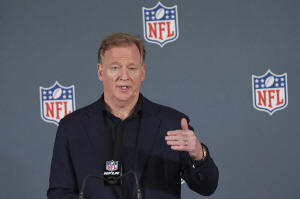Here's how the new NFL rules on
kickoffs and overtime will work
[April 02, 2025]
By JOSH DUBOW
The one-year trial version of the dynamic kickoff in the NFL led to
an uptick in the return rate that wasn't quite as much as the league
had hoped.
Now the new form of the kickoff that is more like a scrimmage play
is permanent with a change for 2025 that the league hopes will lead
to a significant increase in returns.
Owners voted Tuesday to move touchbacks on kicks from the 30 to the
35 in hopes that more teams will kick the ball in play instead of
giving up an extra 5 yards of field position.
The league also approved changes to the overtime rule, expanded
replay assist and made a few other technical changes at the league
meetings in Palm Beach, Florida.
Here’s an explanation of some of the new rules that will be in
place.
What's new with the kickoff?
The league was mostly pleased with the experimental kickoff put in
place for 2024 that led to the rate of kickoff returns increasing
from a record-low 21.8% in 2023 to 32.8% last season, while reducing
the rate of injuries on what had been the game's most dangerous
play.
The rule made kickoffs more like scrimmage plays by placing the
coverage players and blockers close together to eliminate the
high-speed collisions that had contributed to so many injuries on
the play. The league said the rate of concussions dropped 43% on
returns with a significant reduction as well on lower-body injuries.

The problem last season was many teams still opted to kick the ball
in the end zone because the touchback wasn't punitive enough with
the average starting field position on a touchback being only 2.4
further than the average starting position after returns that was
the 27.6-yard line.
By moving the touchback to the 35, the league projects that the
return rate will rise to somewhere between 60% and 70% with a
similar increase in long returns, adding more excitement to the
game.
The league also approved a small tweak to how how blockers on the
return team are allowed to line up in the setup zone that could lead
to longer returns.
How will overtime change?
The league approved a proposal to make regular season overtime more
like the postseason with both teams getting a chance at a
possession, even if the team that got the ball first scored a
touchdown.
The NFL added regular season overtime in 1974, adding a 15-minute
sudden death period that ended on any score. In 2010, the rule was
tweaked to a “modified” sudden death that required an opening
possession touchdown to immediately end the game instead of only a
field goal in both the regular season and playoffs.
Overtime then was shortened for the regular season to only 10
minutes in 2017. A rule change in 2022 for the playoffs only gave
both teams the chance to score even with a touchdown on the opening
possession.
Now that will be the case in the playoffs, after the improved field
position on kickoffs made winning in OT on an opening possession TD
easier.
[to top of second column] |

NFL Commissioner Roger Goodell speaks during a news conference at
the NFL football annual meetings Tuesday, April 1, 2025, in Palm
Beach, Fla. (AP Photo/Lynne Sladky)

According to Sportradar, six of the 16 overtime
games last season ended on an opening drive TD for the most overtime
games ended on the first drive since the rule change went into
effect in 2010.
In all, teams that won the overtime toss won 75% of the time last
season, according to Sportradar, and have a .606 winning percentage
in overtime since it was cut to 10 minutes.
The league kept the 10-minute overtime period instead of expanding
it back to 15 minutes like was originally proposed by Philadelphia,
which could lead teams opting to go for 2 and a win if they match an
opening drive TD with one of their own since there might not be time
for another possession.
Replay assist
The NFL expanded its replay assist system to overturn objective
calls such as facemask penalties, whether there was forcible contact
to the head or neck area, horse-collar tackles, tripping if there
was “clear and obvious” evidence that a foul didn’t occur. Replay
also would be able to overturn a roughing-the-kicker or
running-into-the-kicker penalty if video showed the defender made
contact with the ball.
The league has been using replay assist in recent years to overturn
obvious errors on aspects like whether a pass is caught or where the
ball should be spotted without the referee needing to stop the game
for a review.
The Competition Committee says there's no interest in allowing
replay assists to call penalties on plays missed by officials on the
field.
Other changes
There were a few procedural rules changed. Teams will now by able to
conduct Zoom or phone meetings with prospective free agents during
the so-called legal tampering period.
Teams can place two players on injured reserve with the designation
to return when rosters are reduced to 53 players instead of after.
Playoff teams also will be granted two additional return from IR
designations.
What's up with the tush push?
A proposal by Green Bay to outlaw the tush push that Philadelphia
has used so successfully was tabled until the May meetings. A vote
on a proposal to tweak the onside kick rule also was delayed until
May, along with a proposal by Detroit to change the playoff seeding
to place wild-card teams ahead of a division winner with a worse
record.
All contents © copyright 2025 Associated Press. All rights reserved
 |